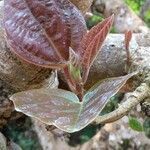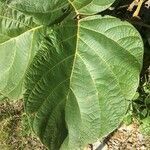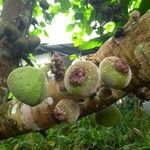Trees, 4-10 m tall, crown elongated and wide, d.b.h. 10-15 cm; dioecious. Bark grayish brown, rough. Branchlets reddish brown, 1-1.5 cm thick, leafless in middle of stem, pubescent. Stipules reddish purple, triangular-ovate, 1.5-2 cm, adaxially shortly pubescent. Leaves alternate; petiole thick, 5-8 cm; leaf blade broadly ovate-cordate, 15-55 × (10-)15-27 cm, thickly papery, abaxially with short spreading pubescence, adaxially glabrous or puberulent on midvein or secondary veins, base cordate to occasionally rounded, margin regularly shallowly dentate, apex obtuse and mucronate; basal lateral veins 4-6, secondary veins 3 or 4 on each side of midvein, abaxially prominent, and adaxially slightly impressed or flat. Figs on specialized leafless branchlets at base of trunk and main branches, reddish brown, pear-shaped, depressed globose, or top-shaped, with 8-12 conspicuous longitudinal ridges, 3-5(-6) cm in diam., white, shortly pubescent when young, glabrescent when mature; peduncle (2-)4-6 cm, thick, pubescent; involucral bracts triangular-ovate; apical bracts in 4 or 5 rows, broadly triangular-ovate, imbricate, rosulate. Male flowers: sessile; calyx lobes 3, transparent, spatulate, thinly membranous; stamens 2; filaments long; anthers ovoid. Gall flowers: calyx lobes 3, apically free, ± covering ovary; style lateral, hairy; stigma enlarged. Female flowers: pedicellate or sessile; calyx lobes 3; ovary ovoid; style lateral, longer than in gall flowers, with hairs. Achenes with adherent liquid. Fl. Aug-Mar, fr. May-Aug.
A fig. It is a small tree. It grows 5-10 m high. The trunk is 30-50 cm across but often less. The crown is broadly spreading. The trunk is usually not straight. The bark is warty and grey. Young shoots are hollow. The young shoots are reddish brown. They are 1-1.5 cm across. The leafy structure at the base of the leaf is triangle shaped and reddish brown. It is 1.5-2 cm long. The leaves are alternate and 10-25-55 cm long by 7-23-27 cm wide. They are rounded and softly hairy underneath. The base is normally deeply heart shaped. There can be small teeth along the leaf edge. The figs grow on the base of the trunk and on short branches of old stems. The fruit is 5-7 cm across. It is green when young and dark red when ripe. The fruit is sweet and with a sweet smell. There are ribs along the fruit.







